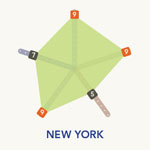Volume VII, Issue 2
Informative representations facilitate comparison. The need, or desire, to compare is the reason information design tools are sought or created. Comparing within contextual frameworks or across systems provides the kind of intelligence that leads to more effective decision-making. For this issue three different approaches to the challenge of developing a logic and creating a representational model based on that logic are presented. One compares bike-sharing programs throughout the United States. The systems within cities that participate in such programs were compared and quantified. Essentially, political/geospatial boundaries provide the contextual framework of comparisons. However, the findings are presented through star graphs with supportive text—our entry deals with the making of the comparative document.
Comparison undergirds social networks as well. In this case, it generally deals with types and levels of interconnectedness; the polygons are supplanted by either uniform cellular walls, or no boundaries at all via links between nodes. The links represent conceptual boundaries. An innovative visualization portraying the interconnectedness of the 2014 International Digital Humanities conference attendees addresses this kind of comparison.
Of course, the choice of what type of representational model is most effective is at the heart of the process to compare data. Our last article pursues this meta-informative task by comparing information design models and the strengths and weaknesses of each to the problem at hand. This brings us back full circle to the user: what the user desires to compare and how the “comparison modeling” supports or distracts from that objective.
Jihoon Kang, Publisher, and William Bevington, Editor-in-Chief
Parsons Journal for Information Mapping

Suitability of Form for Data: An Analysis of Data Visualization Projects
by Deepika Sahai, Lalit Chaudhari, Sindhu MS, & Sindhu S Rao

Representing the Digital Humanities Community: Unveiling The Social Network Visualization of an International Conference
by Dario Rodighiero

Creating Infographics for the Comparison of Bike Share Programs
by Jihoon Kang, MFA & Luca Nitschke

